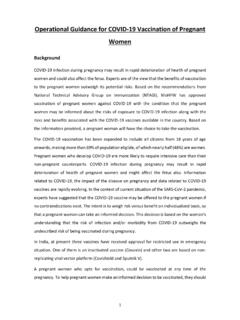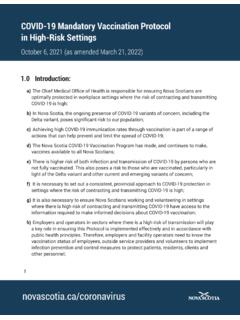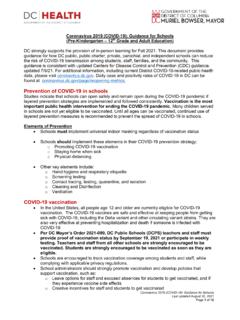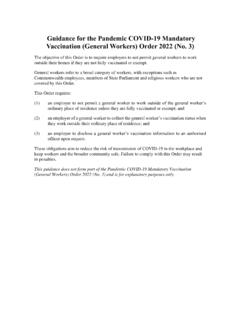Transcription of Sporting events during the COVID-19 pandemic ...
1 Sporting events during the COVID-19 pandemic Considerations for public health authorities Based on existing WHO's guidance 28 May 2021. Across the WHO European Region, governments and event organizers are putting plans in place to restart events that bring together large numbers of people in sometimes crowded settings. These decisions are based on progress in bringing down the number of reported cases and deaths from COVID-19 , due to increasing vaccination coverage, enhanced testing and contact-tracing capacities, adherence to public health and social measures, and emerging treatment options. However, this pandemic is not over yet. Many countries are loosening their public health and social measures, which will favour spread of the virus.
2 Our message is clear: only the coordinated implementation of all public health and social measures will bring transmission down and keep the virus under control. For governments, this means rolling out vaccination, and continuing testing and contact- tracing, quarantine and isolation of contacts and cases, tailored patient care and targeted risk communication. Adherence to individual-level precautionary measures provides the most cost-effective and reliable protection against COVID-19 infection. This means maintaining physical distancing, practising hand and respiratory hygiene, wearing masks and opting for outdoor spaces, or ensuring good ventilation when indoors. The beautiful game: staying safe while watching and playing Sports events can attract a particularly high attendance of domestic and international spectators who come together at stadiums, pitches and fan zones but also before and after the events themselves.
3 These might occur at fan activities, public squares, airports, on buses, trains and other pinch points . where people come together in large numbers. To better protect spectators, athletes, delegates and hosting communities from increased transmission of SARS-CoV-2, and to assist national health systems of the host countries, WHO. strongly recommends the following: 1. Coordinate the decision-making process around an event with all stakeholders, and in particular with the event organizers in an inclusive, transparent and open way. 2. Exercise caution and rethink the need for international travel and organizing mass gathering events where spectators attend in person if community transmission is ongoing.
4 1. 3. Use a risk-based approach to decide whether to hold, modify, postpone or cancel mass gatherings, and tailor decision-making on a factual assessment of the overall risk associated with the event. 4. Enhance public health and social measures if events do take place, not just in competition venues, but also outside in places and on transport used by fans and the host community. WHO has a mandate to support national health authorities to prepare and manage mass gathering events by providing technical guidance, scientific briefs and sharing best practices. WHO has also developed specific guidance and tools for mass gathering events of a Sporting , cultural or religious nature, and elections.
5 Technical guidance to support decision-making for sports events Considerations for sports federations/sports event organizers when planning mass gatherings in the context of COVID-19 : interim guidance. 14 April 2020 2. Guidance for the use of the WHO mass gatherings sports: addendum risk assessment tools in the context of COVID-19 . 30 April 2020 3. WHO Mass gathering COVID-19 risk assessment tool sports events . Guidance for authorities and organizers of sports events planning mass gatherings during the current COVID-19 pandemic . 10 July 2020 4. Implementing a risk-based approach Risk assessment is a continuous process that should occur throughout the period leading up to and during the event, starting from the initial concept of the gathering and stopping only after the event 1.
6 Considerations for implementing a risk-based approach to international travel in the context of COVID-19 . Geneva: WHO; 2020 ( , accessed 27 May 2021). 2. when-planning-mass-gatherings-in-the-con text-of- COVID-19 -interim-guidance, accessed 27 May 2021). 3. Guidance for the use of the WHO mass gatherings sports: addendum risk assessment tools in the context of COVID-19 . Geneva: WHO; 2020 ( mass-gatherings-sports-addendum-risk-ass essment-tools-in-the-context-of- COVID-19 , accessed 27 May 2021). 4. WHO Mass gathering COVID-19 risk assessment tool sports events , version 2. Geneva: WHO; 2020. ( , accessed 27 May 2021). has finished and local systems have returned to normal . 5 It should take into consideration the characteristics of the event (attendees, venues, duration, location, etc.
7 , as well as the context in which the event takes place, including the following factors: changes in COVID-19 transmission patterns in the host country/city and the countries from where spectators and participants are travelling from;. vaccination coverage in the host country;. available treatment options and health -care capacity in the host country;. planned, introduced and adherence to public health and social measures. Enhancing public health and social measures Besides conducting risk assessments, WHO urges Member States to promote and support adherence to public health and social measures in the event venues, as well as outside venues, in the streets, on public transport, in hotels and restaurants, etc.
8 This includes frequent handwashing, respiratory etiquette, wearing a mask, physical distancing, good ventilation and avoiding crowded places or closed settings. These same measures apply also to people who are vaccinated, have recovered from the infection, and know their current status after being tested negative for COVID-19 . If a host country and the event organizer jointly decide to allow international spectators to participate in an event, risk mitigation measures should be considered. WHO recommends that any international travellers to Sporting events comply with the national requirements in place based on the risk assessments undertaken by Member States. WHO 6 and the European Centre for Disease Prevention and Control (ECDC) 7 have issued recommendations on international travel.
9 Enhanced testing. National health authorities of host countries might consider accelerating testing in cities hosting the events before, during and after they take place, to detect an early increase in COVID-19 transmission and the occurrence of possible clusters. The sequencing of viruses should be enhanced and shared to obtain a clearer picture of the possible spread of variants. 8. Coordinated contact-tracing. National IHR focal points (NFPs) of the visitor's country of origin and the game hosting country should coordinate contact-tracing through passenger 5. Public health for mass gatherings: key considerations. Geneva: WHO; 2020. ( , accessed 27. May 2021). 6. COVID-19 diagnostic testing in the context of international travel 7.
10 Travel during the coronavirus pandemic | European Commission ( ). 8. Laboratory testing strategy recommendations for COVID-19 : interim guidance, 21 March 2020. locator forms. Contacts from two days before to 14 days after symptom onset of confirmed cases should be identified, in line with WHO guidance for contact-tracing. 9. Vaccination. WHO promotes any effort to strengthen general vaccine uptake by the population, and to counter vaccine hesitancy. However, WHO. does not recommend prioritizing vaccination roll-out in the host cities or for special groups of people, such as athletes or spectators, as this could lead to vaccine deficits for high-risk groups. Targeted risk communication.













